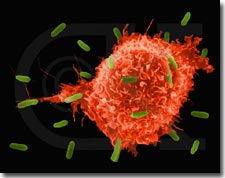Progress in cancer cell detection techniques
Cancer researchers at the University of California, Los Angeles, and the United States (UCLA) have reported a major advance in the detection of cancer cells as they spread through the body. They argue that this advance can apply nanotechnology to detect cancer and determine its rate of spread.
The Jonsson Cancer Center of the university said it used atomic force microscopy to stab a pointed device into the wall of the living cell, thus determining how flexible the cell wall is.
Because cancer cells are forced to contract to fit in tight places as they move through the body, these diseased cells are more flexible than healthy cells. By using nanoscale microscopes and devices that support the use of sharp tip devices, scientists have a new tool to determine if the sample cell is a cancer cell.

(Artwork: Xinhuanet)
UCLA researcher Jianyu Rao said that high-tech optical experiments have replaced long-term techniques including tissue sampling, staining and observation with obsolete optical microscopes to find cells. Cancer-causing anomalies.
'Usually cancer cells have larger nuclei and some difficult to detect features. However, normal cells in the fluid in the body cavities look almost identical to cancer cells when viewed with an optical microscope. '
Chemistry professor James Gimzewski said that the nanotechnology application process is to use a small, pointed tweezers to stab into the cell wall to determine its softness, a sign that it is Cancer cells are developing.
Scientists must use atomic force microscopy to perform this ingenious experiment.
James GImzewski said: 'We have to determine the softness of the cell without breaking it. Or it is like having to use a hammer to know that potatoes are soft or hard. ' He explained: 'Looking at the two tomatoes at the supermarket, they are all red. A fruit is broken but looks normal. You pick up two tomatoes and touch them. It's easy to find out which fruits are broken. We do the same thing. '
- Early detection of blood cancer cells by sound
- Detection of the p53 gene inhibits the growth of cancer cells
- The magic glass helps to see the tumor
- The chip helps detect early cancer cells
- Google developed a cancer detection device
- Cancer treatment: There have been many new techniques
- Detection of gene variants causing esophageal cancer
- Microsoft claims: 10 years from now, humanity is released from cancer
- What is cancer? How does cancer form?
- Rapid detection of cancer with test strips
- CRISPR gene editing technique will make cancer cells no longer immortal
- New tumor detection technique
 Green tea cleans teeth better than mouthwash?
Green tea cleans teeth better than mouthwash? Death kiss: This is why you should not let anyone kiss your baby's lips
Death kiss: This is why you should not let anyone kiss your baby's lips What is salmonellosis?
What is salmonellosis? Caution should be exercised when using aloe vera through eating and drinking
Caution should be exercised when using aloe vera through eating and drinking